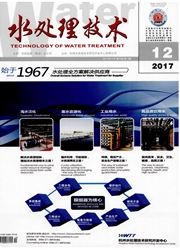

 中文摘要:
中文摘要:
为同步解决钢渣资源化与含油污水预处理的问题,以钢渣为原料制备粒子电极,并用扫描电镜对钢渣粒子电极表面形貌进行表征;以COD去除率为指标的含油污水为处理对象,研究二维电极和三维电极反应器去除含油污水中有机物性能,并对钢渣粒子三维电极反应器运行参数进行优化。结果表明:二维电极在运行电压为20 V,水力停留时间(HRT)为2 h电解条件下,对COD去除率为33.77%,相同条件下三维电极对污水中COD去除率为80.69%,与二维电极相比COD去除率提高了46.92%。利用正交试验考察了运行电压、HRT和初始COD对污水中COD去除率影响,实验表明:初始COD对处理工艺影响最大,处理污水中COD的最佳水平组合是:初始COD为900mg/L,电压为20 V,HRT为2 h。
 英文摘要:
英文摘要:
In order to synchronized solve the problems of steel slag utilization and oily sewage pretreatment, steel slag was used as raw materials to prepare particle electrodes, the surface morphology of steel slag electrodes were characterized by scanning electron microscopes in this study. The processing object was oily water which characterized by COD removal rate, and two-dimensional electrode and three-dimensional electrode reactors were compared by their performance of organic pollutants removal rate in oily water treatment, and the operation parameters of the steel slag particle three-dimensional electrode reactor were optimized. Results showed that when the voltage was 20 V and the hydraulic retention time (HRT) was 2 hours, the COD removal rate of two-dimensional electrodes and three-dimensional electrodes was 33.77% and 80.69%, respectively. The COD removal rate of three-dimensional electrode increased by 46.92% compared to the two-dimensional electrode. The effect of operating voltage, HRT and the initial COD concentration of sewage on COD removal rate was researched by orthogonal test. Results showed that the initial COD concentration had the greatest impact on the process. And the optimum combination of sewage treatment were as follows: the initial COD was 900 mg/L, the voltage was 20 V, and the HRT was 2 h.
 同期刊论文项目
同期刊论文项目
 同项目期刊论文
同项目期刊论文
 期刊信息
期刊信息
